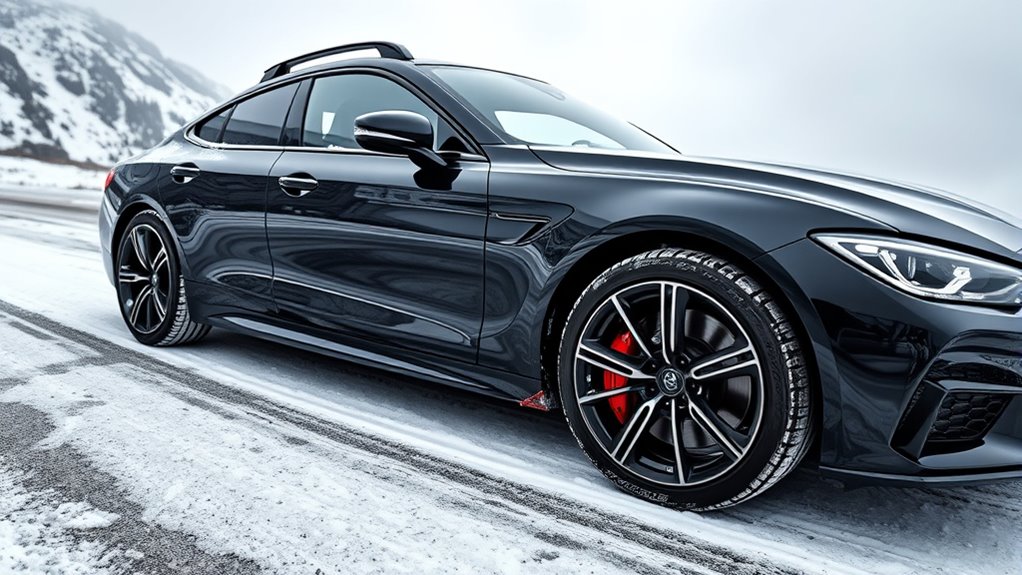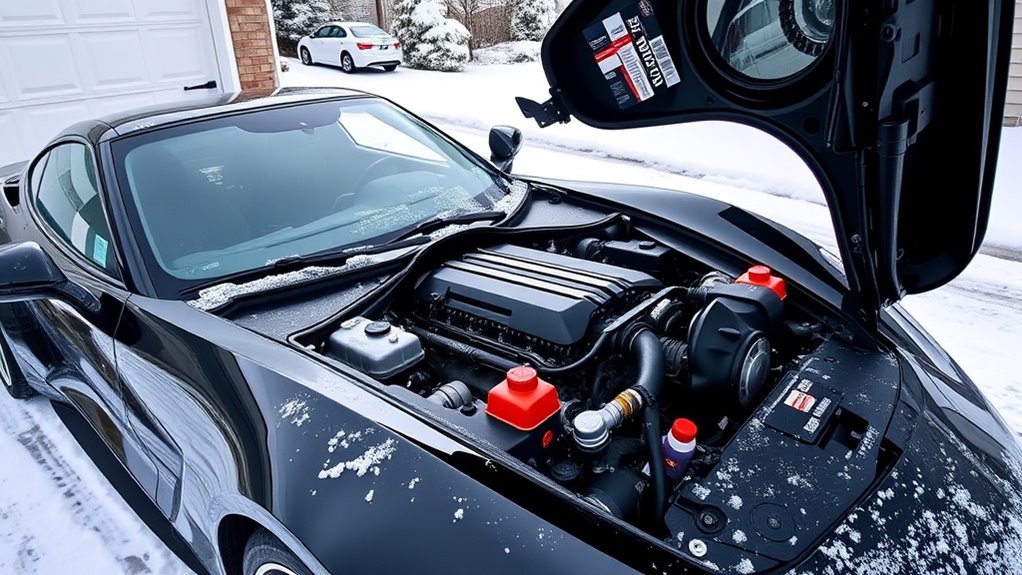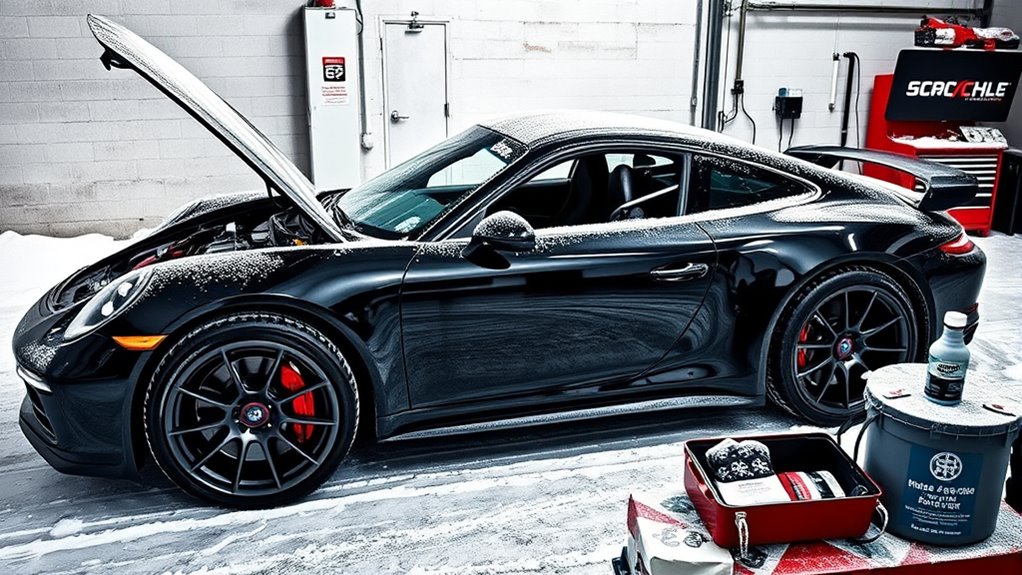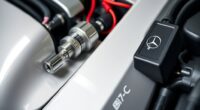To prep your performance-tuned car for winter, focus on optimizing your engine’s cold start system with adjustments to fuel injection, ignition timing, and idle speed. Switch to winter-specific oils, check all fluids, and consider recalibrating your ECU for cold conditions. Use winter tires with proper tread and pressure, maintain a healthy battery, and ensure visibility with tested lighting and defrosters. Keep up with routine maintenance, and you’ll be set for winter’s toughest drives—more tips await to fine-tune your setup further.
Key Takeaways
- Optimize engine tuning by adjusting ECU parameters, ignition timing, and idle speed for cold start stability.
- Use winter-grade oils, check fluid levels, and ensure coolant is properly mixed to prevent freezing and maintain performance.
- Equip your vehicle with winter tires and maintain proper tire pressure for improved traction on snow and ice.
- Maintain the battery by keeping terminals clean, using high-performance batteries, and storing in warm environments for reliable starts.
- Verify that all safety features, lights, and defrosters are functioning properly to ensure visibility and safe driving in winter conditions.
Cold Start Optimization Techniques

When preparing your performance-tuned car for winter, optimizing cold starts is essential to guarantee reliable and smooth engine operation. You’ll want to adjust the ECU by increasing fuel injection to handle denser cold air and poor vaporization. Achieving factory-like performance regardless of ambient temperature is a key goal during cold start tuning, ensuring consistent startup behavior in winter conditions. Tuning ignition timing ensures effective combustion in cold conditions, while raising idle speed helps maintain stability during startup. Using sensors like temperature and oxygen sensors allows the ECU to monitor and fine-tune engine parameters for peak performance. Incorporating electrically heated components can also improve cold start efficiency. Proper tuning might involve increasing throttle opening or air bypass to keep the engine idling smoothly and utilizing sensor calibration for precise adjustments. Additionally, implementing proper fuel mixture adjustments can further enhance cold start reliability in winter conditions.
Enhancing Fuel Efficiency in Winter Conditions

Optimizing cold start techniques sets the stage for better fuel efficiency during winter driving, but maintaining efficiency once the engine is running requires focused adjustments. First, switch to winter-specific motor oils that reduce viscosity and improve engine performance in cold conditions. Limit the use of heaters and defrosters to cut down on extra power drain. Keep your vehicle well-maintained, ensuring air intake systems are clean and functioning correctly to promote complete combustion. Drive smoothly—accelerate gradually, maintain a steady speed, and avoid abrupt stops. Minimize extra loads and use proper gears to reduce strain on the engine. Planning routes to avoid heavy traffic and frequent stops also helps. These steps collectively help you conserve fuel and keep your performance-tuned car running efficiently through winter’s challenges. Proper tire inflation also plays a critical role, as underinflated tires can significantly increase rolling resistance and decrease fuel economy. Additionally, staying informed about automated vehicle maintenance can help identify issues early and improve overall winter performance. Regularly inspecting your vehicle’s fuel system components ensures optimal operation and fuel efficiency in cold weather.
Tire and Traction Readiness for Icy Roads

Ensuring your tires are ready for icy roads starts with selecting the right design and materials. Winter tires feature softer rubber compounds that stay flexible in cold temperatures, improving grip. Their unique tread patterns and sipes maximize traction on ice and snow. Flexibility allows better contact with icy surfaces, reducing slipping risks. Consider these options:
| Tire Type | Key Feature | Best For |
|---|---|---|
| Studded Tires | Metal studs for direct ice traction | Icy, severe winter conditions |
| Studless Tires | Special rubber compounds and tread designs | General icy roads |
| Performance Tires | High grip and handling in winter | Performance vehicles |
Choosing the right tire enhances braking, steering, and overall safety on icy roads, giving you better control during winter drives. Proper tire selection is essential for maintaining safety and handling in winter conditions.
Battery and Electrical System Care in Cold Weather

Cold weather can considerably diminish your car’s battery performance, making it essential to take proactive steps to keep your electrical system in top shape.
At 0°C, a fully charged battery loses about 33% of its starting power, dropping even more at -18°C. The cold slows chemical reactions, reducing current flow and overall power output. Batteries below 12.5V need charging immediately to prevent failure. Additionally, battery chemistry plays a role in how well your battery withstands cold temperatures, so choosing the right type can enhance winter performance.
Upgrading to high-performance batteries like Exide’s Carbon Boost or AGM/EFB types offers 30% more starting power and faster recharging, especially in cold conditions. Regularly check voltage levels, especially if your vehicle sits unused for weeks.
Keep terminals clean, minimize accessory use when engine is off, and consider indoor parking or battery blankets to shield against extreme cold. Battery maintenance is crucial for ensuring your electrical system stays reliable during winter.
Engine Oil and Fluid Management Strategies

Proper engine oil and fluid management are essential for maintaining your vehicle’s performance during winter. Selecting the right engine oil, such as low-viscosity or multi-viscosity grades like 10W-30, ensures better cold start lubrication and reduces engine wear. Always follow your manufacturer’s specifications to optimize performance. Engine oil viscosity grades are crucial; colder temperatures cause oils to thicken, impairing flow. Regularly check all fluids—engine coolant, transmission fluid, and gear lubricants—to prevent freezing or overheating. Use high-quality fluids stored in warm, dry places to uphold their properties. Consider additives like viscosity index improvers or antioxidants to enhance lubrication and extend fluid life. Avoid common mistakes like using incorrect viscosity oils or neglecting fluid checks, which can impair performance or cause damage. Proper management keeps your engine running smoothly and reliably throughout the winter months.
Winter Tuning for Peak Performance

Winter tuning for peak performance involves adjusting your vehicle’s settings to optimize traction, responsiveness, and reliability in cold conditions. You should recalibrate ECU maps to account for winter fuel blends with ethanol, preventing engine knock. Proper fuel mixture is essential to ensure optimal combustion and prevent issues related to cold starts. Tuning boost pressure in colder weather increases air density, enhancing turbo response while maintaining safety. Modify cold-start enrichment to accommodate thicker fluids and reduced battery capacity. Recalibrate traction control and torque distribution to improve grip on icy surfaces, mimicking rally-inspired systems. Managing intercooler efficiency by updating charge-cooling maps to prevent overcooling and condensation. Additionally, exploring remote hackathons can provide opportunities to develop innovative tuning solutions and share expertise with a global community. Engaging with online performance tuning forums can also offer valuable insights and shared experiences from fellow enthusiasts. Fine-tuning these parameters ensures your car remains responsive and reliable in winter’s harsh environment, maximizing performance without compromising safety. Proper winter tuning helps your performance-tuned car excel on snow and ice.
Preventative Maintenance for Cold-Weather Driving

Are you prepared to keep your performance-tuned car reliable when temperatures drop? Cold weather demands extra attention to your vehicle’s fluids, battery, tires, and visibility. Check engine oil with winter-grade viscosity, ensure coolant is properly mixed to prevent freezing, and top off transmission and brake fluids. Use winter washer fluid to keep your windshield clear.
Inspect your battery’s charge, terminals, and cables; replace it if it’s old. Maintain tire pressure, check tread depth, and consider winter tires for better traction. Verify headlights, taillights, and defrosters work efficiently. Regularly inspect for corrosion and damage.
| Fluid Checks | Tire & Battery Maintenance |
|---|---|
| Use winter oil | Check tire pressure regularly |
| Coolant mix | Inspect battery terminals |
| Top up fluids | Ensure tires have sufficient tread |
Frequently Asked Questions
How Often Should I Update My Winter-Specific Engine Tuning Settings?
You should update your winter-specific engine tuning settings at least once a year before the cold season begins.
However, if you switch to winter fuel blends or notice changes in engine performance, do it immediately.
Keep an eye on air density, fuel quality, and sensor calibration.
Regular data logging helps guarantee your adjustments match winter driving conditions, keeping your car running smoothly and safely throughout the season.
Can Cold Weather Reduce the Lifespan of My Performance Car’S Electronic Components?
Cold weather can definitely reduce the lifespan of your performance car’s electronic components. When temperatures drop, electrical resistance increases, putting extra stress on parts like sensors, wiring, and connectors.
Moisture from winter conditions can cause corrosion or short circuits, further damaging your system. To protect your electronics, regularly inspect and clean connections, keep components dry, and consider winter-specific upgrades to help extend their longevity.
What Are the Best Practices for Storing My Tuned Vehicle During Extended Winter Absences?
For extended winter storage, you should clean your vehicle thoroughly and protect it from moisture.
Top off all fluids, including fuel and coolant, and check the oil.
Elevate the car on jack stands to prevent tire flat spots.
Disconnect the battery, and cover the vehicle with a quality cover.
Keep it in a dry, climate-controlled space if possible, and implement rodent deterrents to prevent damage.
How Does Winter Driving Affect the Calibration of Performance Suspension Settings?
A stitch in time saves nine, and that’s true for your suspension. Winter driving slows down shock responsiveness, stiffens springs, and hardens bushings, all affecting handling.
You’ll need to soften spring rates, adjust anti-sway bars, and recalibrate your suspension to maintain stability on icy roads.
Regular inspections help catch moisture damage or wear early, ensuring your performance setup stays tuned for winter’s tough conditions.
Are There Any Risks in Using High-Performance Fuels During Winter Months?
Using high-performance fuels in winter can pose risks, especially if you don’t choose the right blend. Cold temperatures may cause fuel gelling, leading to clogged lines. Moisture contamination can freeze, blocking fuel flow.
Higher costs and increased sensitivity to contamination mean you need to be extra vigilant. To avoid issues, select winterized or seasonal fuels, add winter-specific additives, and maintain your fuel system regularly for peak performance.
Conclusion
Remember, a well-prepared car is your best ally in winter’s toughest conditions. By following these tips, you’ll keep your performance-tuned vehicle running smoothly and safely. Regular maintenance and thoughtful adjustments are key—think of it as tending a garden: neglect now, and you’ll regret it later. Stay proactive, stay safe, and enjoy winter driving without worry. After all, an ounce of prevention is worth a pound of cure.










